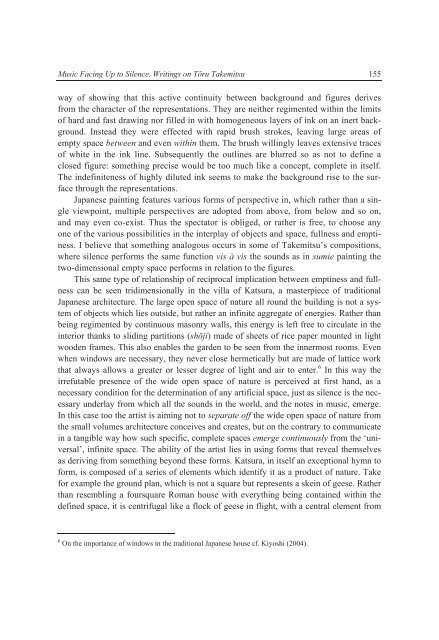Musica che affronta il silenzio - Scritti su Toru Takemitsu - Pavia ...
Musica che affronta il silenzio - Scritti su Toru Takemitsu - Pavia ...
Musica che affronta il silenzio - Scritti su Toru Takemitsu - Pavia ...
Create successful ePaper yourself
Turn your PDF publications into a flip-book with our unique Google optimized e-Paper software.
Music Facing Up to S<strong>il</strong>ence. Writings on Tru Takemit<strong>su</strong><br />
way of showing that this active continuity between background and figures derives<br />
from the character of the representations. They are neither regimented within the limits<br />
of hard and fast drawing nor f<strong>il</strong>led in with homogeneous layers of ink on an inert background.<br />
Instead they were effected with rapid brush strokes, leaving large areas of<br />
empty space between and even within them. The brush w<strong>il</strong>lingly leaves extensive traces<br />
of white in the ink line. Subsequently the outlines are blurred so as not to define a<br />
closed figure: something precise would be too much like a concept, complete in itself.<br />
The indefiniteness of highly d<strong>il</strong>uted ink seems to make the background rise to the <strong>su</strong>rface<br />
through the representations.<br />
Japanese painting features various forms of perspective in, which rather than a single<br />
viewpoint, multiple perspectives are adopted from above, from below and so on,<br />
and may even co-exist. Thus the spectator is obliged, or rather is free, to choose any<br />
one of the various possib<strong>il</strong>ities in the interplay of objects and space, fullness and emptiness.<br />
I believe that something analogous occurs in some of Takemit<strong>su</strong>’s compositions,<br />
where s<strong>il</strong>ence performs the same function vis à vis the sounds as in <strong>su</strong>mie painting the<br />
two-dimensional empty space performs in relation to the figures.<br />
This same type of relationship of reciprocal implication between emptiness and fullness<br />
can be seen tridimensionally in the v<strong>il</strong>la of Kat<strong>su</strong>ra, a masterpiece of traditional<br />
Japanese architecture. The large open space of nature all round the bu<strong>il</strong>ding is not a system<br />
of objects which lies outside, but rather an infinite aggregate of energies. Rather than<br />
being regimented by continuous masonry walls, this energy is left free to circulate in the<br />
interior thanks to sliding partitions (shji) made of sheets of rice paper mounted in light<br />
wooden frames. This also enables the garden to be seen from the innermost rooms. Even<br />
when windows are necessary, they never close hermetically but are made of lattice work<br />
that always allows a greater or lesser degree of light and air to enter. 6 In this way the<br />
irrefutable presence of the wide open space of nature is perceived at first hand, as a<br />
necessary condition for the determination of any artificial space, just as s<strong>il</strong>ence is the necessary<br />
underlay from which all the sounds in the world, and the notes in music, emerge.<br />
In this case too the artist is aiming not to separate off the wide open space of nature from<br />
the small volumes architecture conceives and creates, but on the contrary to communicate<br />
in a tangible way how <strong>su</strong>ch specific, complete spaces emerge continuously from the ‘universal’,<br />
infinite space. The ab<strong>il</strong>ity of the artist lies in using forms that reveal themselves<br />
as deriving from something beyond these forms. Kat<strong>su</strong>ra, in itself an exceptional hymn to<br />
form, is composed of a series of elements which identify it as a product of nature. Take<br />
for example the ground plan, which is not a square but represents a skein of geese. Rather<br />
than resembling a foursquare Roman house with everything being contained within the<br />
defined space, it is centrifugal like a flock of geese in flight, with a central element from<br />
6 On the importance of windows in the traditional Japanese house cf. Kiyoshi (2004).<br />
155

















